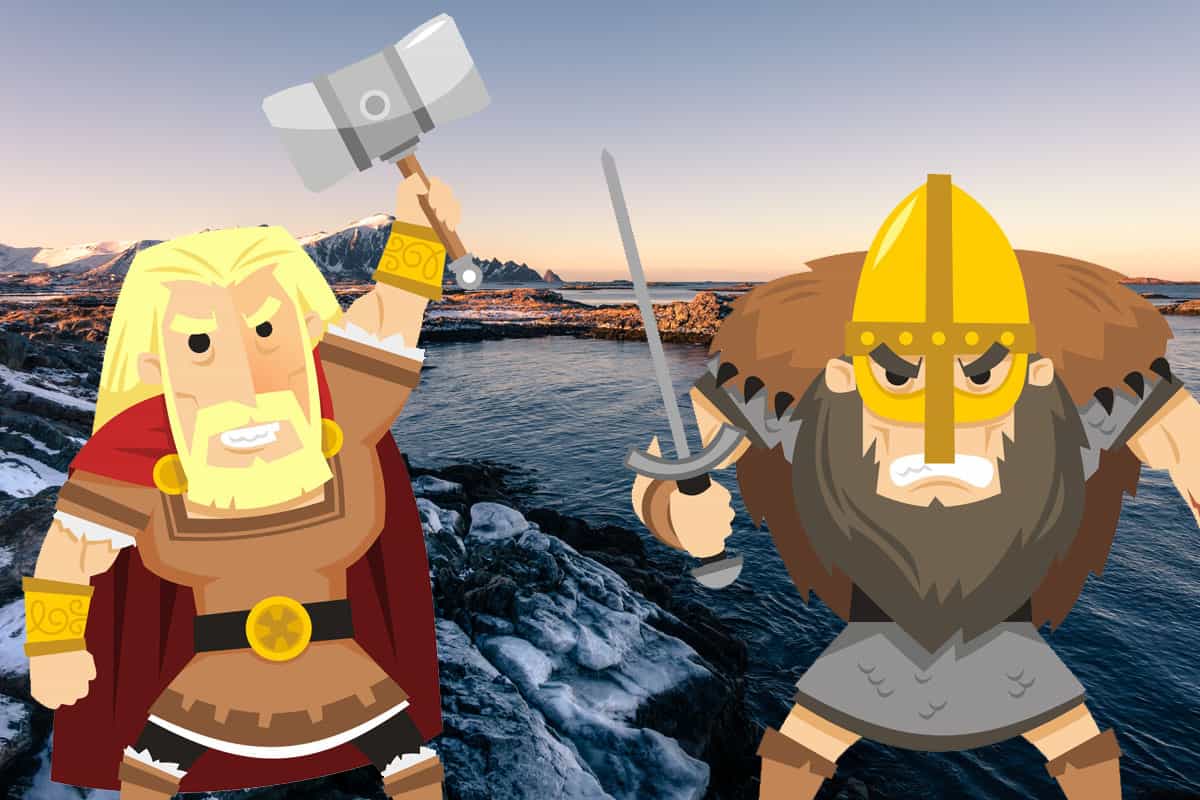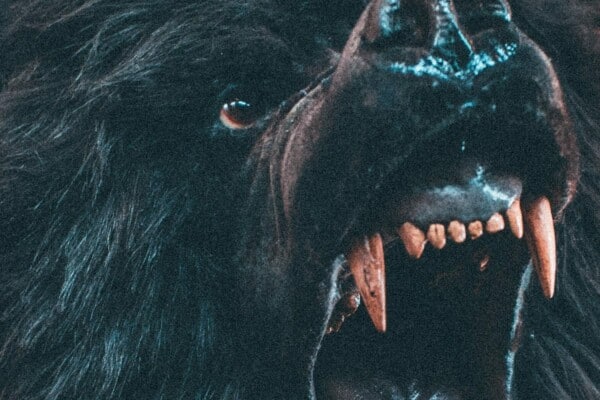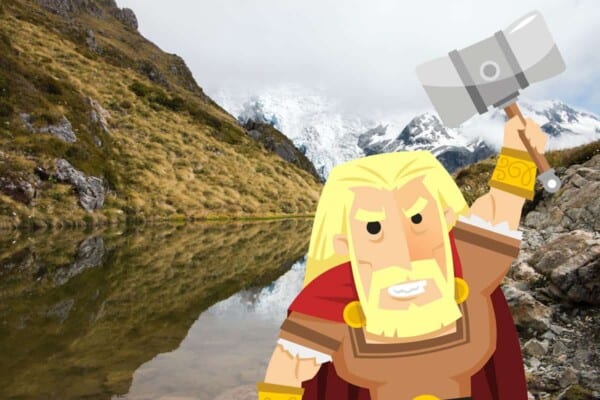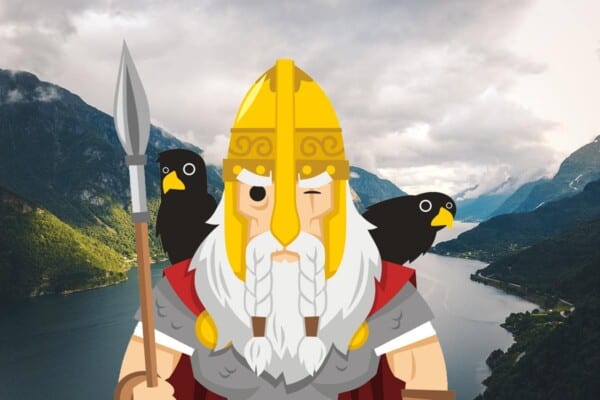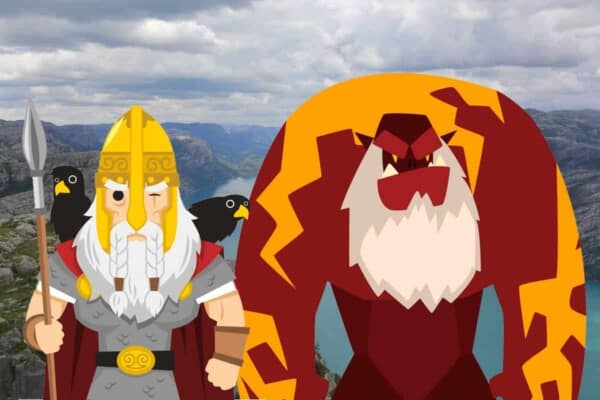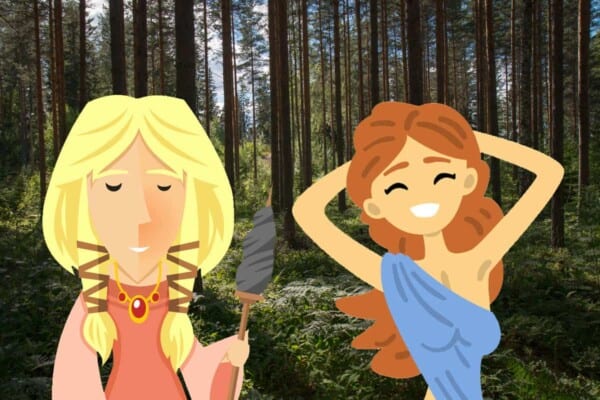There were a whole bunch of deities fighting for the position of coolest Norse gods, goddesses, and giants. This is because one has to include all of the Æsir (primary pantheon), Vanir (secondary pantheon), and Jötnar (troll-giants)!
The following list is pretty subjective – everyone has different favorites! – but we’ve tried to gather a general consensus of the nine coolest around. Nine was a special number in Norse mythology. It was the number of worlds on Yggdrasil, sacrificial feasts lasted nine days, and Heimdall had nine mothers – just as a few examples!
The Æsir Gods
1. Týr
Tyr gave his name to the day of the week we now know as Tuesday! His father was either the jötunn Hymr or the leader of the Æsir, Odin. He was one of the principal war gods of the pantheon and had a strong sense of bravery and justice. In fact, he’s most well known for sacrificing his own hand to the wolf-monster Fenrir in order to trap him away until Ragnarök!
During the end of their phase of the world – Ragnarök – Týr was fated to do battle with the wolf guardian of Helheimr’s gates, the blood-soaked dog Garmr. The creature would be released from its chains at Ragnarök and Týr would fight to defend the world from him. They would battle so ferociously that both would end up slaying the other.
2. Sif
She was the beautiful golden-haired wife of Thor, and her fortitude made her quite the worthy wife! In fact, so respected was she that often in kennings Thor was referred to as “Sif’s husband” rather than the other way around! Sig was known for calmly staring down threats and challenges without flinching.
At one point, while the mischief god Loki was enjoying himself mocking all of the gods, Sif calmly poured him a cup of mead. She remarked that there was nothing that he could do to insult her, no matter what she had to say to the other gods. Loki tried to find a fault with her and could not, so falsely claimed that he was her lover. Sif didn’t even dignify him with a response and the conversation moved on.
Loki once pranked Sif by shaving off all of her golden hair. Thor was enraged, but at Sif’s encouraging did not attack the mischief god. Instead, he sent him on a quest to get a new hairpiece for Sif – which ended with the crafting of his hammer, Mjölnir.
3. Þórr (Thor)
As well as storms, he was a god of strength and fertility as well as a protector of mankind. His name and all of its variants meant ‘thunder.’ Thor’s hammer, Mjölnir, was a common icon for amulets and decoration. It was both a symbol of brutal strength and of divine blessing. His mother was Jörd, a giantess, and his father, Odin. He married Sif and fathered gods and goddesses with her and a few other mothers.
Thor was the most physically powerful of the gods. He was charged with the protection of all of Asgard. He was fated to battle the terrifying Serpent of Midgard, Loki’s world-encompassing son Jörmungandr. Thor was the only being powerful enough to slay the beast. Although he was fated to be successful, however, he was also cursed to die shortly after defeating Jörmungandr as he would succumb to its venom.
The god was also renowned for his ability to outmatch the jötnar, with whom the Æsir often found themselves at war.
The Vanir Gods
4. Freyja
Freyja was a goddess of love, war, gold, and magic. She was sometimes conflated with Frigg, the goddess of foresight and wife of Odin. However, the two were also considered separate deities. Freyja’s beauty was such that she was always sought out as a bride, especially from the attacking jötnar. However, the only husband she cared for was Óðr (sometimes Odin).
She ruled over Fólkvangr, where half of the brave who died in battle went after death. The others went to Valhalla, the realm of Odin. Freyja also possessed a magic cloak that could grant flight to its bearer, and she often passed this to the other gods in their times of need. Her father was the god Njörðr and his sister-wife, who was unnamed. Her twin brother was Freyr (below).
Freyja ruled over Fólkvangr from her majestic hall known as Sessrúmnir. Her name could be invoked in matters of love and fertility, where she would offer help.
5. Freyr
Freyr, son of Njörðr and his unnamed sister-wife and twin brother of Freyja, was heavily associated with Sweden and considered the ancestor of the Swedish royal line. He was associated with royalty, peace, and pleasure and is often depicted with an erect phallus. He ruled over Álfheimr, the realm of the elves.
His most known story involves his courtship and marriage to Gerðr. She was a female jötunn and the most beautiful woman in the world. He fell in love with her at first sight and swore to do all he could to win her heart. After they met, she agreed to marry him, but only if he would give up his mighty sword, which could fight battles all on its own.
Freyr did not think twice and quickly gave up the weapon in exchange for her hand. When he later faced the jötunn Beli, he defeated the mighty giant with nothing but an antler as a weapon.
6. Gullveig
Her name meant something along the lines of “gold-draught,” and she was considered by many as a personification of gold. She was also named Heiðr, meaning ‘bright’ or ‘clear.’ Gullveig played an essential role in the conflict between the two pantheons.
She turned up at the hall of Odin, where the Æsir looked forward to a great victory by slaying her. However, they could not keep her down. They stabbed at her with spears, but she would not fall. After, they burned her alive, not once but three times. Each time she rose unscathed. After that, she left and became a wise figure who passed on her magic.
Gullveig practiced seidr, a kind of magic associated with the future. She trained “wicked women” in this. Though many deemed her and her followers as evil, later readings saw her as a route of freedom for women who did not fit within their proper societal roles of the time.
The Jötnar (Giants)
7. Þrúðgelmir (Thrudgelmir)
Þrúðgelmir was a frost giant and the son of the primordial giant Ymir or Aurgelmir. He was born from his father’s legs, while his older unnamed brother and sister were born from his armpits. Þrúðgelmir was also the father of Bergelmir.
Þrúðgelmir was particularly significant as he possessed six heads atop his gigantic body. His name meant “strength yeller,” and he could probably create loud, terrifying noises from each of his six mouths. His children would be some of the ancestors of all of the Jötnar.
When Ymir was defeated by Odin and his brothers, Þrúðgelmir also met with a grizzly end. Ymir’s flesh became the earth and his blood the ocean. While the gods were arranging this, Þrúðgelmir tried to fight back and ultimately drowned in his own father’s blood.
8. Rán
The ocean giantess Rán and her Jötunn husband Ægir were both personifications of different versions of the sea. While Ægir represented the peacefulness and fertility of the ocean, Rán was its anger. Stories written about her told how anyone who angered her would be torn from their ships and dragged to their deaths in the depths of the ocean.
Rán’s name meant ‘thief, robber’ and indicated how she took the lives of those who gained her displeasure. Several poems display the poet’s anguish and desire for revenge against the goddess who destroyed their loved ones.
She once loaned her net to Loki after the trickster god borrowed it in a quest to retrieve some gold for Odin. Loki was successful in his mission, and Ran got her net back, which she used to drown men.
The Icelandic seafarers believed in a land of the dead below the sea, specifically for those killed by the ocean. This realm was ruled entirely by Rán without her husband’s help.
9. Vafþrúðnir (Vafthruthnir)
This giant’s power lay in his extreme wisdom. While many were personified as brutal, he was truly dangerous in his intelligence, which was completely unmatched until Odin. His name is a combination of the words for weaving and might, and it can be read as “strong in riddles”.
Odin wished to test his wisdom against the giant, though his wife Frigg warned that Vafþrúðnir may be too mighty both in strength and intelligence. A disguised Odin challenged the giant, and the contest covered events of past, present, and future. The giant and the god met each other wit for wit until Odin asked what he had whispered in Baldr’s ear before lighting his son’s funeral pyre.
Vafþrúðnir realized then who he has been battling with and graciously accepted his defeat.

